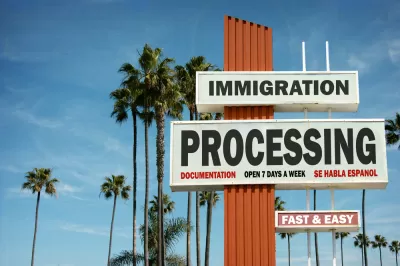A comprehensive study on Latino population growth in the U.S. has been released by Pew Research Center based on a study of 2007-2014 census data. Two factors are responsible for the slowing growth: reduced fertility and immigration rates.

In June 2012, a Pew Research Center study indicated that "Asians have surpassed Hispanics as the largest wave of new immigrants to the United States," (also posted here). Now Pew has released a detailed study with accompanying infographics and fact sheets to gain a better understand of how the nation's largest ethnic minority has been changing since 2007.
"Between 2007 and 2014, the U.S. Hispanic population grew annually on average by 2.8% (its pace of growth has been an even slower 2.4% between 2010 and 2014)," writes the authors of the study, Renee Stepler and Mark Hugo Lopez.

Courtesy of Pew Research Center
This was down from a 4.4% growth rate between 2000 and 2007 and down from 5.8% annually in the 1990s. As a result, the Hispanic population, once the nation’s fastest growing, has now slipped behind Asians (whose population grew at an average annual rate of 3.4% from 2007 to 2014) in its growth rate. [Asians has surpassed Hispanics in 2013 as the fastest growing minority group].
As for all the campaign talk about "securing the borders," when it comes to Mexico, Pew reported last year that "from 2009 to 2014, more Mexicans and their families (including U.S.-born children) left the U.S. for Mexico...than left Mexico to come to the U.S."
The main driver of Latino population growth in the U.S. shifted from immigration in the last two decades of the last century to births in the oughts. Birth rates declined almost 27 percent from 2006 to 2014.
- Despite slowing population growth, Latinos still accounted for more than half (54%) of the nation’s population growth between 2000 and 2014.
The report also centers on geographic population dispersal, "beginning in the 1990s, just as Latino population growth was accelerating."
- The South continues to lead in Hispanic population growth, but three fastest growing counties are in North Dakota [as of 2014].
- The five states with the largest Hispanic populations are California (15 million), Texas (10.4 million), Florida (4.8 million), New York (3.7 million) and Illinois (2.2 million). Together, these states hold 65% of all Hispanics.
- See more 'key facts about how the U.S. Hispanic population is changing.'
Additional information:
- Associated Press: Study: Latino population growth slips behind Asian Americans
- Pew Research Center: Hispanic/Latino Demographics
FULL STORY: U.S. Latino Population Growth and Dispersion Has Slowed Since the Onset of the Great Recession

Alabama: Trump Terminates Settlements for Black Communities Harmed By Raw Sewage
Trump deemed the landmark civil rights agreement “illegal DEI and environmental justice policy.”

Study: Maui’s Plan to Convert Vacation Rentals to Long-Term Housing Could Cause Nearly $1 Billion Economic Loss
The plan would reduce visitor accommodation by 25% resulting in 1,900 jobs lost.

Planetizen Federal Action Tracker
A weekly monitor of how Trump’s orders and actions are impacting planners and planning in America.

Waymo Gets Permission to Map SF’s Market Street
If allowed to operate on the traffic-restricted street, Waymo’s autonomous taxis would have a leg up over ride-hailing competitors — and counter the city’s efforts to grow bike and pedestrian on the thoroughfare.

Parklet Symposium Highlights the Success of Shared Spaces
Parklets got a boost during the Covid-19 pandemic, when the concept was translated to outdoor dining programs that offered restaurants a lifeline during the shutdown.

Federal Homelessness Agency Places Entire Staff on Leave
The U.S. Interagency Council on Homelessness is the only federal agency dedicated to preventing and ending homelessness.
Urban Design for Planners 1: Software Tools
This six-course series explores essential urban design concepts using open source software and equips planners with the tools they need to participate fully in the urban design process.
Planning for Universal Design
Learn the tools for implementing Universal Design in planning regulations.
Caltrans
Smith Gee Studio
Institute for Housing and Urban Development Studies (IHS)
City of Grandview
Harvard GSD Executive Education
Toledo-Lucas County Plan Commissions
Salt Lake City
NYU Wagner Graduate School of Public Service


























